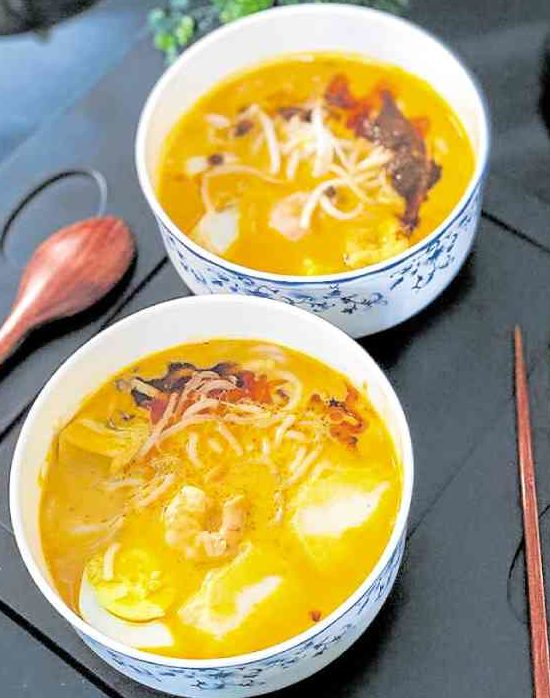
I am fond of laksa, especially the spiced orange-fire, coconut milk-based kind.
What makes laksa special is its spice paste, made by pounding and blending together the perfect amounts of ginger, garlic, chilies, turmeric, dried shrimp, shrimp paste and lemongrass.
Spice paste recipes vary from one cook to another, but in Manila, it’s Tao Yuan’s Singaporean chef Ah Long’s rendition that brings me the greatest pleasure (tel. 0917-6383911, @taoyuan on Instagram).
Tao Yuan’s laksa is a perfect balance. From a spoonful of broth, the palate experiences ecstasy. It is a complex structure of tastes, a hint of this and that: a bit of citrus and ginger, some muskiness from turmeric, and a mellow whisper of garlic and fiery chilies, tempered by the natural sweetness of coconut milk. Add to that the unique flavor that shrimp in all its forms—paste, dried and fresh—contributes to the dish.
The other components bring the laksa together: noodles that are cooked on point, bouncy fish balls, exquisite fish cake and the sambal that is added just before the dish is served.
Croissant, pigeon, ‘puto’
Thanks to Park Avenue desserts chef Buddy Trinidad, I’ve been feasting on Paris through his croissants (tel. 88526141).
His croissants are puffy and very flaky, and smell of butter. With good jam and even more French butter, it is heaven in a bite.
His chocolate croissants are delicious, as well. The cross section is impressive! By the visuals alone, one could tell that it was perfectly executed.
Trinidad said his secret was simply the right technique and good butter.
“We’ve been doing it forever!” said Rita Trinidad. “Since we’re a neighborhood bakery, it has sort of been one of those best-kept neighborhood secrets.”
Thanks to Patty Pineda, I have discovered Rosita Yap’s ready-to-fry pigeon marinated in special herbs (tel. 0917-8512892).
Yap is a natural-born cook, and pigeon is one her specialties. It has a nice, clean taste.
I’ve had the finest, softest yet chewiest puto with kalamay hati by Ninay’s of Lipa (tel. 0917-8402303), established in 1931 by Agustina de la Peña.
I’ve tasted many, but Ninay’s is a cut above the rest. It is said the process of making the puto alone takes three days. Ninay’s uses only first-class rice that is ground twice.
The impeccable puto is made even more sinful by the kalamay hati, sauce resembling a buttery caramel with a satin finish.
Passion fruit vinegar
Joy Valenton of Kabise Farms learned how to make cider vinegar because of a surplus of sour native santol that no one wanted.
After months of experimentation and product testing, Valenton confidently launched her vinegar line and called it Kabise (tel. 0917-8455694), in honor of her father, Mario S. Garcia, as he was fondly called by the townsfolk of Cabanatuan City, where he served as mayor for years.The fruits Joy uses for her vinegars were all planted in their backyard by her father and grandfather Dionisio. To ensure that that the fruits are free of pesticides, she makes use only of her own harvest.
Kabise vinegars are fermented the old-fashioned way, with no additives or preservatives. Joy adds a bit of spice to her concoctions. Her vinegars can be enjoyed as dipping sauces. There are five variants: Bignay, Cacao, Sampalok, Santol and Passion Fruit, which is my favorite.
Visit reggieaspiras.com, follow @iamreggieaspiras